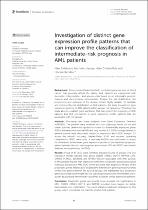| dc.contributor.author | Eshibona, Nasr | |
| dc.contributor.author | Livesey, Michelle | |
| dc.contributor.author | Christoffels, Alan | |
| dc.date.accessioned | 2023-03-15T07:47:49Z | |
| dc.date.available | 2023-03-15T07:47:49Z | |
| dc.date.issued | 2023 | |
| dc.identifier.citation | Eshibona, N. et al. (2023). Investigation of distinct gene expression profile patterns that can improve the classification of intermediate-risk prognosis in AML patients. Frontiers in Genetics, 14, 1131159. | en_US |
| dc.identifier.issn | 1664-8021 | |
| dc.identifier.uri | https://doi.org/10.3389/fgene.2023.1131159 | |
| dc.identifier.uri | http://hdl.handle.net/10566/8585 | |
| dc.description.abstract | Acute myeloid leukemia (AML) is a heterogeneous type of blood cancer that generally affects the elderly. AML patients are categorized with favorable-, intermediate-, and adverse-risks based on an individual’s genomic features and chromosomal abnormalities. Despite the risk stratification, the progression and outcome of the disease remain highly variable. To facilitate and improve the risk stratification of AML patients, the study focused on gene expression profiling of AML patients within various risk categories. Therefore, the study aims to establish gene signatures that can predict the prognosis of AML patients and find correlations in gene expression profile patterns that are associated with risk groups. Microarray data were obtained from Gene Expression Omnibus (GSE6891). The patients were stratified into four subgroups based on risk and overall survival. Limma was applied to screen for differentially expressed genes (DEGs) between short survival (SS) and long survival (LS). DEGs strongly related to general survival were discovered using Cox regression and LASSO analysis. To assess the model’s accuracy, Kaplan-Meier (K-M) and receiver operating characteristic (ROC) were used. | en_US |
| dc.language.iso | en | en_US |
| dc.publisher | Frontiers Media | en_US |
| dc.subject | Bioinformatics | en_US |
| dc.subject | Leukemia | en_US |
| dc.subject | Cancer | en_US |
| dc.subject | Patient | en_US |
| dc.subject | Genetics | en_US |
| dc.title | Investigation of distinct gene expression profile patterns that can improve the classification of intermediate-risk prognosis in AML patients | en_US |
| dc.type | Article | en_US |

